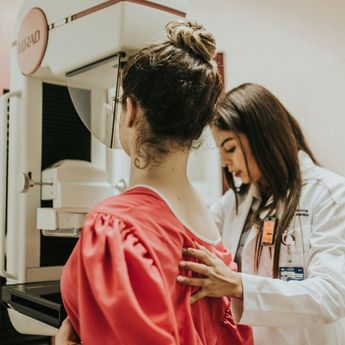By continuing to use our site, you consent to the processing of cookies, user data (location information, type and version of the OS, the type and version of the browser, the type of device and the resolution of its screen, the source of where the user came from, from which site or for what advertisement, language OS and Browser, which pages are opened and to which buttons the user presses, ip-address) for the purpose of site functioning, retargeting and statistical surveys and reviews. If you do not want your data to be processed, please leave the site.
The Voice of People With Breast Cancer
Information
Breast Cancer Basics
Understanding Risk Factors
Risk Reduction Strategies
There is no guaranteed way to prevent breast cancer, but certain actions can reduce your risk. Prevention focuses on two main goals:
- Lowering known risk factors
- Encouraging protective behaviors
These strategies are especially important because most breast cancer cases occur in people with no strong family history, suggesting that lifestyle and environmental exposures play a significant role.
Understanding Risk
Breast cancer develops from a combination of genetic, hormonal, environmental, and lifestyle factors. While you can’t control things like age, sex, or family history, you can make choices that may lower your risk. Even modest changes—like improving diet or getting regular exercise—can make a difference over time.
Healthy Lifestyle Choices
Looking to reduce your risk? Small, consistent changes can have a big impact over time. Here are key strategies supported by research:
- Maintain a healthy weight by combining regular movement with balanced eating habits.
- Be physically active—aim for at least 150 minutes of moderate aerobic activity each week, plus strength training twice weekly.
- Limit alcohol to no more than 1–2 drinks per week, or avoid it altogether.
- Avoid smoking and limit your exposure to second-hand smoke.
- Choose a balanced diet with lots of vegetables, fruits, whole grains, legumes, and calcium-rich dairy, while limiting red and processed meats.
For more information on how these factors influence breast cancer risk, see the Modifiable Risk Factors section.
Related reading from Our Voices Blog:
Protective Factors
Certain reproductive and hormonal factors may also offer protection against breast cancer:
- Breastfeeding, especially for longer durations, has been shown to modestly reduce breast cancer risk, so if you're able, it may provide some benefit.
- Having a full-term pregnancy before age 30 may slightly reduce lifetime risk, though this is a personal and complex decision influenced by many factors.
- Postmenopausal hormone therapy, especially combined estrogen-progestin, increases breast cancer risk. If you’re considering hormone therapy to manage menopause symptoms, it’s important to talk to your healthcare provider about non-hormonal alternatives.
Additional Options for Higher-Risk Individuals
If you have a strong family history, a known genetic mutation (such as BRCA1 or BRCA2), or conditions like DCIS or LCIS, your healthcare team may recommend more proactive strategies to reduce your risk. See the High-Risk Conditions section for more details on prevention strategies for these conditions.
Medical Review by Roochi Arora, MD, FRCPC, August 2025
- References
-
American Cancer Society. (2021). Can I lower my risk of breast cancer? https://www.cancer.org/cancer/types/breast-cancer/risk-and-prevention/can-i-lower-my-risk.html
Canadian Cancer Society. (2025). Reducing your risk for breast cancer. https://cancer.ca/en/cancer-information/cancer-types/breast/risks/reducing-your-risk
Emaus, M. J., van Gils, C. H., Bakker, M. F., Bisschop, C. N., Monninkhof, E. M., Bueno-de-Mesquita, H. B., Travier, N., Berentzen, T. L., Overvad, K., Tjønneland, A., Romieu, I., Rinaldi, S., Chajes, V., Gunter, M. J., Clavel-Chapelon, F., Fagherazzi, G., Mesrine, S., Chang-Claude, J., Kaaks, R., Boeing, H., … May, A. M. (2014). Weight change in middle adulthood and breast cancer risk in the EPIC-PANACEA study. International Journal of Cancer, 135(12), 2887–2899. https://doi.org/10.1002/ijc.28926
My Breast Screening. (2024). Your comprehensive guide to breast cancer screening in Canada. https://www.mybreastscreening.ca/wp-content/uploads/2024/07/DBC-Screening-Guide_draft15_optimized.pdf
Rebbeck, T. R., Friebel, T., Lynch, H. T., Neuhausen, S. L., van 't Veer, L., Garber, J. E., Evans, G. R., Narod, S. A., Isaacs, C., Matloff, E., Daly, M. B., Olopade, O. I., & Weber, B. L. (2004). Bilateral prophylactic mastectomy reduces breast cancer risk in BRCA1 and BRCA2 mutation carriers: The PROSE Study Group. Journal of Clinical Oncology: Official Journal of the American Society of Clinical Oncology, 22(6), 1055–1062. https://doi.org/10.1200/JCO.2004.04.188
Reimers, L., & Crew, K. D. (2012). Tamoxifen vs Raloxifene vs Exemestane for Chemoprevention. Current breast cancer reports, 4(3), 207–215. https://doi.org/10.1007/s12609-012-0082-8
Sauter E. R. (2018). Breast cancer prevention: Current approaches and future directions. European Journal of Breast Health, 14(2), 64–71. https://doi.org/10.5152/ejbh.2018.3978
SHARE




